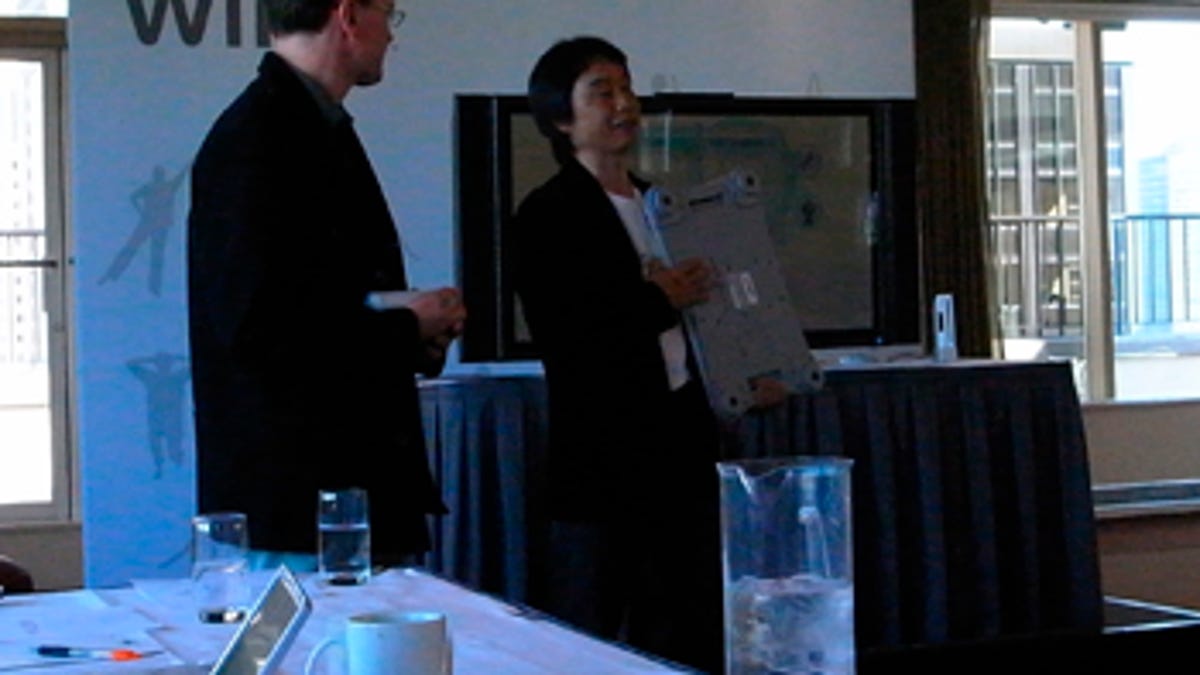Up close with Shigeru Miyamoto and 'Wii Fit'
CNET attended a Q&A session with Nintendo Senior Managing Director Shigeru Miyamoto on Thursday regarding <i>Wii Fit</i>'s arrival in North America.

CNET was more than happy to attend an exclusive roundtable Q&A regarding Wii Fit with Nintendo mastermind Shigeru Miyamoto on Thursday afternoon at the Le Parker Meridien in New York. Miyamoto led the presentation with an in-depth look at the origin of Wii Fit and the challenges that came along in developing such an ambitious platform.
Interestingly enough, Wii Fit was conceived by Miyamoto in the process of his own personal awareness of his body weight. By graphing his weight over a period of time, he was able to see a visual representation of how it fluctuated. With his family encouraging him to keep in shape, Miyamoto did so by creating a personal game out of the whole thing--as a result, Wii Fit was born.
What separates Wii Fit from other "working-out-can-be-fun" concepts is that it creates a game around each person who plays it. Nintendo hopes that this personalized experience will attract people who would otherwise not be playing video games--and we think they're on to something. By making Wii Fit an easy-to-use, practical, and accessible device, it can appeal to just about anyone who can stand on a scale. Wii Fit may not have you dropping pounds as fast as intense exercise and dieting would, but it can definitely make keeping track of your progress a whole lot easier and definitely more entertaining. Miyamoto explained that Wii Fit makes you more aware of your body, which is the first step toward improving your health. Wii Fit is already starting to pop up in gyms across Japan and we'd imagine a similar response here in the states.
Coming off the overwhelming success Wii Fit has already secured in Japan--more than 2 million units have been sold so far--Nintendo is ready to bring the balance board to North America. While Wii Fit has become somewhat of a family sensation in Japan, Miyamoto says he's not sure how an American audience will receive the game. When we asked Miyamoto what he expected from American consumers, he noted that on average, American families are apart more often than those in Japan. A lot of families have parents who have separated or divorced, so it's tougher to predict the role family will play in the American response to Wii Fit--and we couldn't agree more. While there are sure to be families who will scoop the game up for its health-oriented encouragements, we think Wii Fit will also be a hit with individuals and those who live independently.
Miyamoto then proceeded with a demonstration of the Yoga section of Wii Fit. He showed how the balance board helps you become aware of your own balance and posture by displaying it onscreen in a way that is easy to understand. Most people who get on the board for the first time are surprised at how uneven their stance is and are eager to try to improve their overall posture. The game bundled with the balance board is split into two features; a weight and body mass index tracker, and a training section. Once you've created a profile (of course, you can use your Mii character), you take an initial balance test that will combine your age, BMI, and weight, and calculate your Wii Fit age. This number is used to track your progress and ultimately encourage you to get it lowered. Once you start completing the various strength training, aerobic, yoga, and balance games, you earn Fit Credits--the in-game currency that lets you unlock more challenges.
The Wii Fit balance board is quite an advanced piece of hardware. With four sensors in each of the corners on the board, the device has a large spectrum of data it can measure. Miyamoto explained that the board lets your body essentially become the joystick, something rarely attempted in video games.
But where do we go from here? If Wii Fit is as successful in North America as it has been in Japan, there will be a seemingly endless amount of directions Nintendo can take with incorporating the balance board into other applications besides Wii Fit. Miyamoto explained that once there's a solid install-base of Wii Fit users, Nintendo can entertain third-party game developer's interest in creating games that take advantage of the hardware. This has already taken place in Japan with a skiing game from Namco Bandai. Miyamoto even flirted with the idea of incorporating connectivity with the Nintendo DS as a part of Wii Fit--we're certainly hoping that will come to fruition. On whether we could see the balance board being used in first-party Nintendo games, Miyamoto said it's possible that it could be included as an optional input device.
For now, Miyamoto looks ahead to other projects for the Wii, mentioning his desire to continue the Pikmin series.
Wii Fit will go on sale May 19 in North America. Be sure to check CNET in the coming weeks for a full review.
Check out Kara Tsuboi's report on WiiWare and Wii Fit:

